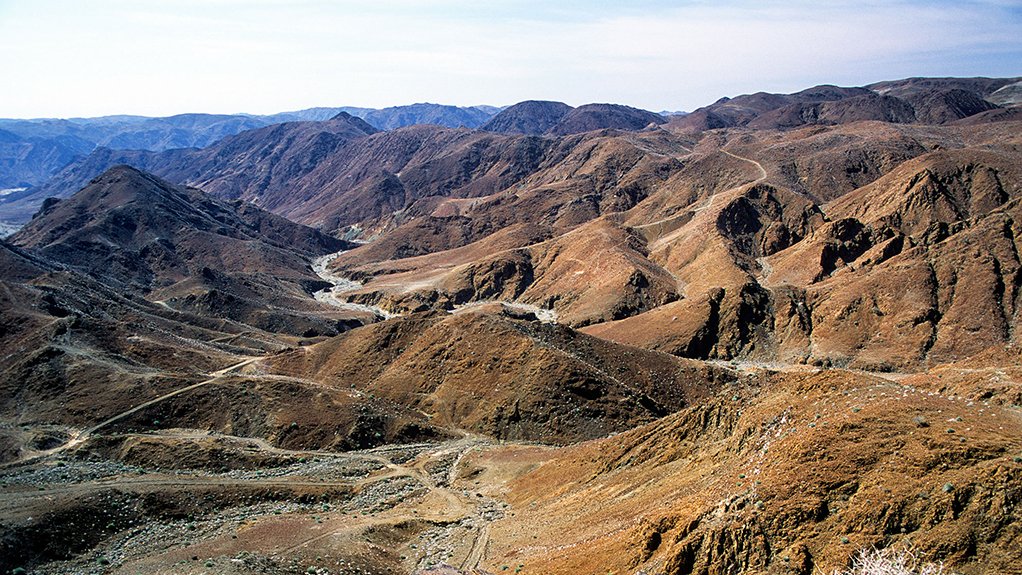TSX-V-listed Deep-South Resources has announced the third batch of assay results from its drilling programme, which was interrupted in June 2021, at its Haib copper project in southern Namibia.
The programme, which was renewed this month, was interrupted when the Namibian Ministry of Mines and Energy denied the renewal of the Haib copper licence EPL 3140.
Following a legal challenge, the licence has since been renewed.
Results from 12 drill holes have been received after the renewal denial of the licence.
Deep-South has completed its quality assurance and quality control (QA/QC) on the first six drill holes. The QA/QC on the remaining results is underway and they will be disclosed within seven days. A total of 22 holes were drilled and 19 were sent for assaying. The remaining three samples will be prepared and eventually sent for assaying.
"Previous drilling programmes point to the presence of higher copper grade zones, probably associated with near vertical structures (shears and faults) within the broader mineralised areas of the project.
“The use of vertical drilling in the past potentially missed those structures resulting in an underestimation of the overall grade,” Deep-South president and CEO Pierre Léveillé said.
He added that the drilling programme was focussed on redressing this through the use of inclined holes to identify and delineate these structures and test the association with higher copper grade zones.
“These results seem to support this updated interpretation, showing substantial intersections at copper grades considered high for Haib. Additionally, the presence of molybdenum has been confirmed with high molybdenum grades obtained in association with structures and alterations,” Léveillé said.
The six holes for which assay results reported cover 1 193.59 m and cover all four of the target areas.
All holes were positioned to better delineate the previously identified higher-grade portions of the Haib copper project and to test the extension of grade between these targets.
The previously undisclosed results reveal the intersection of a section measuring 64 m, showing a concentration of 0.61% copper equivalent (CuEq) – a combination of copper and molybdenum.
Within this larger intersection, there were two notable subsections. The first subsection spanned 16 m, starting from a depth of 26 m, and displayed an even higher concentration of 0.79% CuEq. The second subsection covered 14 m and exhibited a concentration of 0.71% CuEq.
At hole HM27, Deep-South found a section measuring 14 m from the surface, showing a CuEq concentration of 0.48%.
At HM28, a significant intersection measuring 64 m displayed a CuEq concentration of 0.61%. This intersection included two noteworthy subsections: the first was a 16-meter stretch with a higher concentration of 0.79% CuEq, and the second was a 14-m section with a concentration of 0.71% CuEq.
At HM29, the exploration revealed an 18-m section with a CuEq concentration of 0.56%.
HM30 showcased an intersection spanning 50 m, with a CuEq concentration of 0.37%. Within this larger section, a 4-m subsection displayed an even higher concentration of 1.09% CuEq.
At HM31, Deep-South discovered a section measuring 10 m, which showed a CuEq concentration of 0.40%.
Finally, at HM31R, the company encountered two notable segments. The first section covered 12 m and displayed a CuEq concentration of 0.53%. The second section, measuring 22 m, showed a slightly lower concentration of 0.45% CuEq.
A total of 22 holes were completed in 2021 and, by the time the licence renewal was declined in June of that year, samples for 19 holes had been submitted to the laboratory.
Results for eight holes were disclosed by then, with a further six holes disclosed on July 26. The remaining six will be disclosed upon completion of Deep-South’s QA/QC.
The programme was planned for 10 000 m, of which 4 800 m was completed in 2021. The remaining 5 200 m will be completed as soon as the site preparation is one.
The specific focus of the drilling campaign is to further delineate and grow the higher-grade areas of the Haib deposit uncovered by Deep-South in 2019 and 2020, with the ultimate goal of establishing a measured resource over that higher-grade section of the deposit.
Edited by: Chanel de Bruyn
Creamer Media Senior Deputy Editor Online
EMAIL THIS ARTICLE SAVE THIS ARTICLE
ARTICLE ENQUIRY
To subscribe email subscriptions@creamermedia.co.za or click here
To advertise email advertising@creamermedia.co.za or click here













